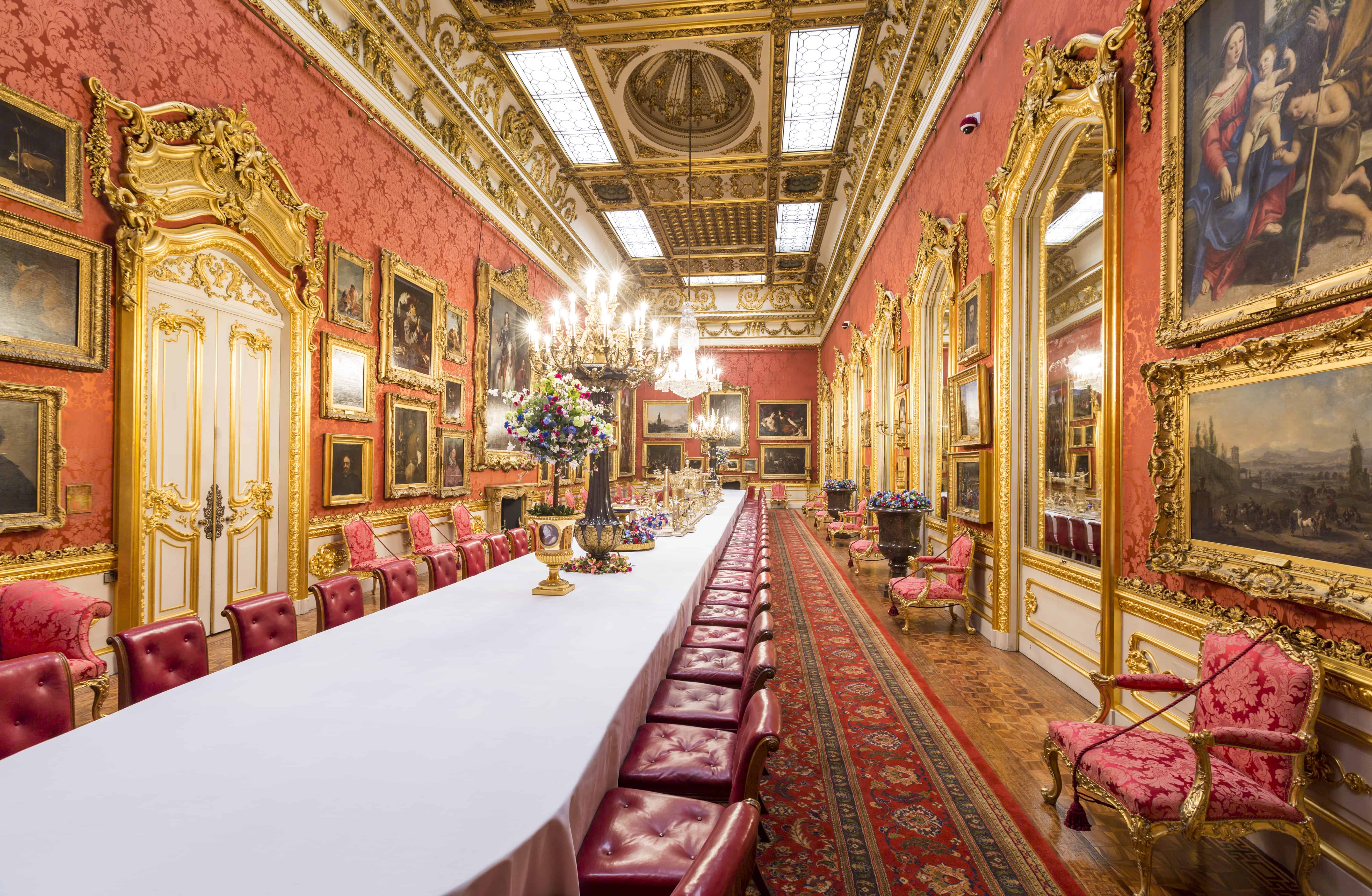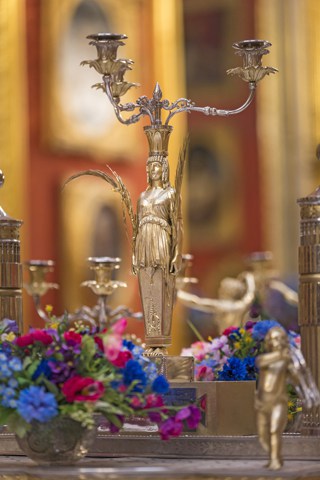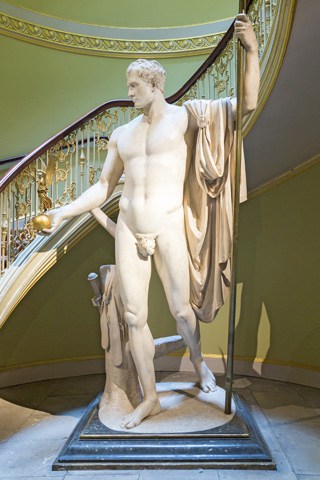Some of the exhibits at the Duke of Wellington’s London residence are cheekier than you’d expect. Bernard O’Shea leaves no stone unturned, especially the marble in the stairwell.
I’ve seen Napoleon’s butt and I liked it. Arthur Wellesley, the first Duke of Wellington, liked it too – so much so that he took it home with him so that he could admire it permanently.
Napoleon Bonaparte’s near-naked body – there’s a fig leaf at the front – is on display for all to see in Apsley House (pictured above), which to this day is the London residence of the Dukes of Wellington. It’s an enormous (three metre-plus) marble statue of Napoleon as Mars the Peacemaker by leading Italian sculptor Antonio Canova.
Napoleon commissioned the work in 1802 and Canova spent four years working on it, but when the emperor finally got to see it, set up in the Louvre museum in Paris in 1811, Napoleon didn’t like it. He felt it was “too athletic”. Are you kidding! What man wouldn’t want to be portrayed with a beautifully chiselled athletic body?
Call that a well-filled fig leaf?
Napoleon should have been flattered, but the fussy, grumpy emperor ordered that the statue be covered up and hidden from the public in the storerooms of the Louvre. Perhaps it was the rather modest size of the fig leaf that he objected to (although leading British art critic Brian Sewell has described Canova as “a master of the well-filled scrotum”).
The British government, more alert to the work’s artistic merits, bought the statue in 1816 and presented to Wellington. Taking it home with him was a bit of a problem, though – the only place where it could fit properly in his grand, three-storey mansion was at the base of the stairwell, where the floorboards had to be reinforced to support it. Note that, to inspect the butt, you have to wander around behind the statue into to the awkward little nook underneath the stairwell; not many visitors do that, but Bernardo boldly goes where others fear to tread, all in the name of investigative journalism.
Lots of loot
There are many reasons to visit Apsley House, apart from studying Napoleon’s anatomy. The Duke of Wellington (who had two spells as British prime minister) acquired an impressive array of artworks, most notably the “Spanish royal collection”. These were the 70-plus paintings that Napoleon’s art-loving brother Joseph Bonaparte, who had been installed on the Spanish throne, had looted from Spanish royal palaces and couldn’t bear to part with, so he took them with him (rolled up, out of their frames) in his carriage when he fled Madrid as Wellington’s army approached. But in Vitoria in Northern Spain he had to abandon his carriage and continue his escape on horseback, leaving the paintings behind.
Wellington offered to return them to King Ferdinand VII of Spain, but the monarch, grateful to have his throne back, said he could keep them. Even now, some 200 years later, they hang on the walls of Apsley House, which had to be extended to display them. They include four masterpieces by Diego Velazquez (one of which, The Waterseller of Seville, the artist rated as his best work) and The Agony in the Garden, by Correggio (which was Wellington’s favourite). There are also works by the likes of Goya, Rubens, Brueghel, Van Dyck, Teniers and David Wilkie.

Mad about platters
Of course, you should also visit Apsley House if you are interested in British politics and military history – on display, for example are the swords carried by both Wellington and Napoleon at the battle of Waterloo – but if you have a fetish for candlebra, soup tureens, classical gilt-edged porcelain plates, fruit platters, vases and ice-cream pails, then this is the place for you!
The crockery amassed by Wellington as gifts in thanks for his defeat of Napoleon is astounding, and most of it is beautifully displayed in the Plate and China Room on the ground floor of Apsley House. Highlights include:
- A 292-piece Prussian service, commissioned by King Frederick William III of Prussia in 1816 and delivered three years later. It includes tureens and ice-coolers with battle scenes painted on them;
- A Saxon service, commissioned by Frederick Augustus IV of Saxony in 1818, all the pieces decorated with scenes of famous battles in the Peninsular and other wars;
- A 66-plate Egyptian dinner service made by the Sevres porcelain factory in France, presented by King Louis XVIII as an expression of thanks for his restoration to the throne. (Napoleon had given it to his wife, Josephine, as a divorce present, but she rejected it as being “too severe”.)
- A silver-gilt Waterloo shield with 10 battle scenes on it, and matching a pair of candlebra, a gift from the merchants and bankers of London.
1000 pieces of silver
The most fascinating exhibit, though, laid out on a grand table upstairs in the State Dining Room, is a 1000-plus silver and silver-gilt service presented to Wellington by the Portuguese Council of Regency in 1816. It is the work (four years in the making) of Domingos Antonio de Sequeira, a court painter who had never done any metalwork before, but for a beginner he did a magnificent job.
The towering centrepiece comprises 21 plateaux each with allegorical figures, beasts, columns and military symbols, and culminates in dancing nymphs and figures representing the four continents paying tribute to the united armies of Portugal, England and Spain. Thousands and thousands of silver coins had to be melted for it, and Portugal almost went bankrupt in the making of it.
Bernardo is a very honest person who has never stolen any silverware from any hotel, restaurant, café or canteen, but with this silver service he was sorely tempted. However, you would need pockets the size of doonas to have any chance of getting away with it. TTW
Bernard O’Shea travelled to London at his own expense. Apsley House is at 149 Piccadilly, wedged in between Hyde Park Corner and Buckingham Palace Gardens, as are the Wellington Arch and the Australian War Memorial. For more information, go to english-heritage.org.uk. Photos © English Heritage.



